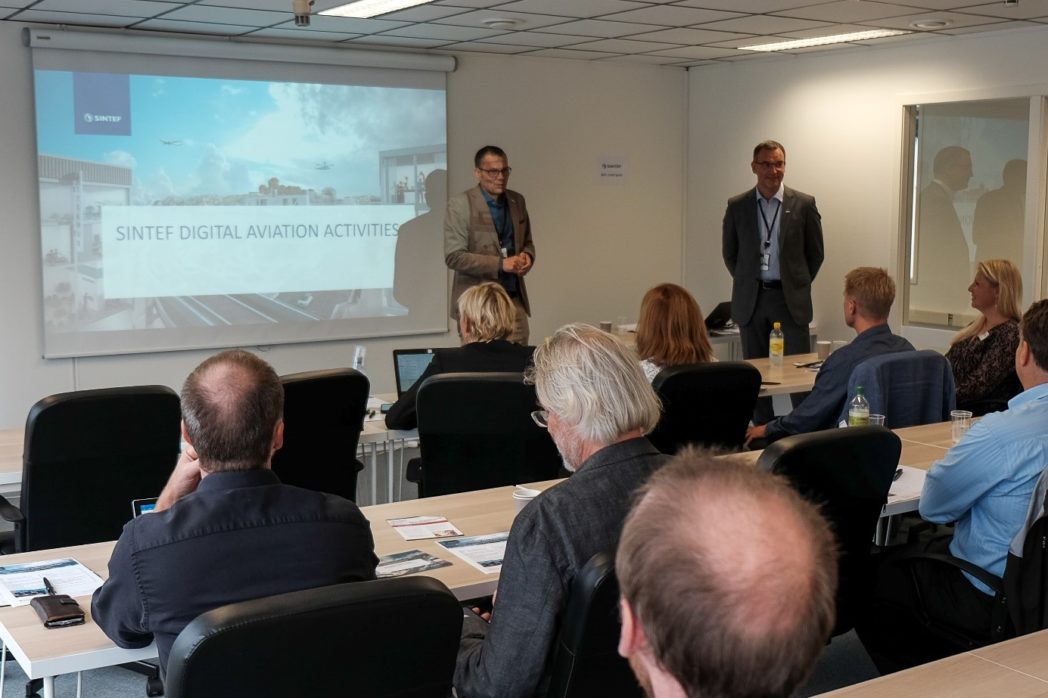SINTEF is heavily involved in aviation projects, and last week we presented several of them at the SINTEF Aviation Open Day, where actors such as research institutes (DLR and FFI) Air Navigation Service Providers/Airport owners (Naviar/Coopans, NUAC and Avinor) manufacturing industry (Frequentis), the Research Council of Norway and the Ministry of Transport and communications were present.
The objective of the open day was to show concepts and technology which are under development at SINTEF and let research and “real world” meet, exchange views and discuss future collaborations. In this blog we sum up some of the concepts and technology we presented at the Open Day.

Since 2008 SINTEF participated in approximately 50 aviation projects in SESAR, in addition to the Aviation and Avionic projects we are running outside SESAR. SESAR is the Single European Sky Air Traffic Management Research program co funded by EC, EUROCONTROL and the ATM Industry. SESAR 1 lasted from 2008 until the end of 2016 (2,1B€). SESAR 2020 started in 2016 and will continue until 2024. The work of SESAR is done through at Joint Undertaking (SJU) where there are 19 industry members in addition to the founding members (EC and EUROCONTROL). NATMIG Consortium is one of the 19 industry members, and consists of Saab, Airtel and SINTEF). The industry partners contribute with 1/3 of the budget, which in total is 1,6 B€. Including all consortium partners and Linked Third Parties more than 100 organizations and 3000 experts are included in the technological development of the Air Traffic Management system in Europe
SIMADES ATC – Simulating en-route traffic
SINTEF’s simulator and validation platform – SIMADES ATC has recently been used for the evaluation of the Dynamic Airspace Configuration (DAC) within SESAR 2020 PJ08 project. The simulator has been developed by our Optimisation group and our Human Computer Interaction group. It simulates en-route traffic, cope with changes of airspace sector configurations, and provides support for ATCO and pseudo-pilot Control Working Positions. Different visualizations of changing configurations have been developed within SESAR 2020 PJ16 project. We presented SIMADES ATC platform and gave a demonstration of its use with DAC concept.
PJ03 – optimizing ground operations
In the SESAR2020 PJ03 project – Enhanced Guidance Assistance to Aircraft and Vehicles on the Airport Surface Combined with Routing – SINTEF has combined continuous routing and scheduling of vehicles with AGL-based guiding of each vehicle, to optimise ground operations and reduce the controllers’ workload.
An overall, de-conflicted plan governs the movements of all vehicles. This is re-evaluated every few seconds, to tackle the high level of dynamics in ground operations. Necessary route adjustments are communicated to the controllers, while speed and priority control is communicated to aircraft crew using TCLs and taxiway stop bars.
EARTH – improving runway and airport throughput
SESAR2020 PJ02 project EARTH – Enhanced RWY Throughput – focuses on separation and procedures to improve runway and airport throughput considering wake-vortex, weather, environment and noise, while taking into account future traffic demand, aircraft capability and airport configurations.
SINTEF is involved in the development and validation of a system that enables tower and approach controllers to optimize mixed arrival and departure runway operations while ensuring safe operations. SINTEF contributes with methods and software for coordinated arrival, departure, and surface management, utilizing their ATC Optimisation Library.
H2020 DARWIN – crisis management
The H2020 DARWIN project aims to develop state of the art resilience management guidelines and innovative training modules for crisis management. The guidelines, which will evolve to accommodate the changing nature of crises, are developed for those with responsibility of critical infrastructure/services from policy to practice.
A prototype DARWIN mini game based on virtual reality was demonstrated to participants. During the crisis, the situation unfolds with different events flooding, bridge collapse, rabbits attack. The resilience manager selects agencies and resources to rescue victims. The debrief would include reflections around resilience capabilities. The project results have been co-created with partner end users and a Community of practitioners (currently 160 members from 23 countries representing different critical infrastructures). More about DARWIN here.














Comments
No comments yet. Be the first to comment!